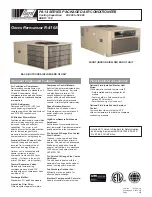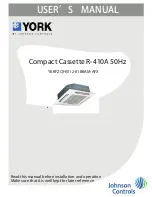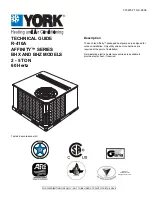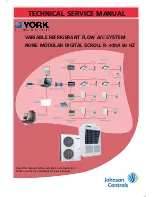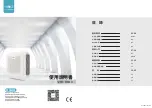
Users in European Countries may be required to properly dispose of this unit. This appliance contains
refrigerant and other potentially hazardous materials. When disposing of this appliance, the law
requires special collection and treatment.
DO NOT
dispose of this product as household waste or
unsorted municipal waste.
24
25
Test Run
European Disposal Guidelines
Before Test Run
A test run must be performed after the entire
system has been completely installed. Confirm
the following points before performing the test:
a)
The indoor and outdoor units are properly
installed.
b)
Piping and wiring are properly connected.
c)
Ensure that there are no obstacles near the
inlet and outlet of the unit that might cause
poor performance or product malfunction.
d)
The refrigeration system does not leak.
e) The drainage system is unimpeded and
draining to a safe location.
f) The heating insulation is properly installed.
g)
The grounding wires are properly connected.
h)
The length of the piping and the added
refrigerant stow capacity have been
recorded.
i)
The power voltage is the correct voltage
for the air conditioner.
Failure to perform the test run may result in
unit damage, property damage or personal injury.
Test Run Instructions
1.
Open both the liquid and gas stop valves.
2.
Turn on the main power switch and allow the
unit to warm up.
3.
Set the air conditioner to COOL mode.
4.
For the Indoor Unit
a. Ensure the remote control and its buttons
work properly.
b.
Ensure the louvers move properly and can
be changed using the remote control.
c.
Double check to see if the room
temperature is being registered correctly.
d.
Ensure the indicators on the remote
control and the display panel on the indoor
unit work properly.
e.
Ensure the manual buttons on the indoor
unit works properly.
f.
Check to see that the drainage system is
unimpeded and draining smoothly.
g. Ensure there is no vibration or abnormal
noise during operation.
5.
For the Outdoor Unit
a.
Check to see if the refrigeration system is
leaking.
b.
Make sure there is no vibration or
abnormal noise during operation.
c.
Ensure the wind, noise, and water
generated by the unit do not disturb your
neighbors or pose a safety hazard.
6.
Drainage Test
a.
Ensur
e the drainpipe flows smoothl
y. New
buildings should perform this test before
finishing the ceiling.
b.
Remove the test cover. Add 2,000ml of
water to the tank through the attached
tube.
c.
Turn on the main power switch and run
the air conditioner in COOL mode.
d.
Listen to the sound of the drain pump to
see if it makes any unusual noises.
e.
Check to see that the water is discharged.
It may take up to one minute before the
unit begins to drain depending on the
drainpipe.
f.
Make sure that there are no leaks in any of
the piping.
g.
Stop the air conditioner. Turn off the main
power switch and reinstall the test cover.
NOTE:
If the unit malfunctions or does not
operate according to your expectations,
please refer to the Troubleshooting section
of the Owner’s Manual before calling
customer service.
CAUTION
When disposing of this appliance, you have the following options:
•
Dispose of the appliance at designated municipal electronic waste collection facility.
•
When buying a new appliance, the retailer will take back the old appliance free of charge.
•
The manufacturer will also take back the old appliance free of charge.
•
Sell the appliance to certified scrap metal dealers.
NOTE:
Disposing of this appliance in the forest or other natural surroundings endangers your
health and is bad for the environment. Hazardous substances may leak into the ground water
and enter the food chain.
Summary of Contents for FHA-H54R410INV9
Page 14: ...25 24 1 2 3 4 2 000 5 6...
Page 20: ...1 5 2 5 13 12 2 4 6 3 1 2 3 4 57 4 67 67 4 5 8 4 9 4 1 5 2 5 3 5 1 2 3 60cm 23 6 M1 Fig 4 6...
Page 22: ...9 8 L N 1 2 3 4 5 6 7 1 2 3 4 5 6 7 8 9 10 5 6 7 8 9 10 MC MC 10 14 17 18 21 23 25 4 1...
Page 23: ...7 6 2 2 1 2 1 2 1 1 1 1 1 1 1 2 1 1 1 1 1 2 1 2 3 50 5 4 24 5 25 3 9 ST3 9 12 ST 2 9 10 AAA...


























